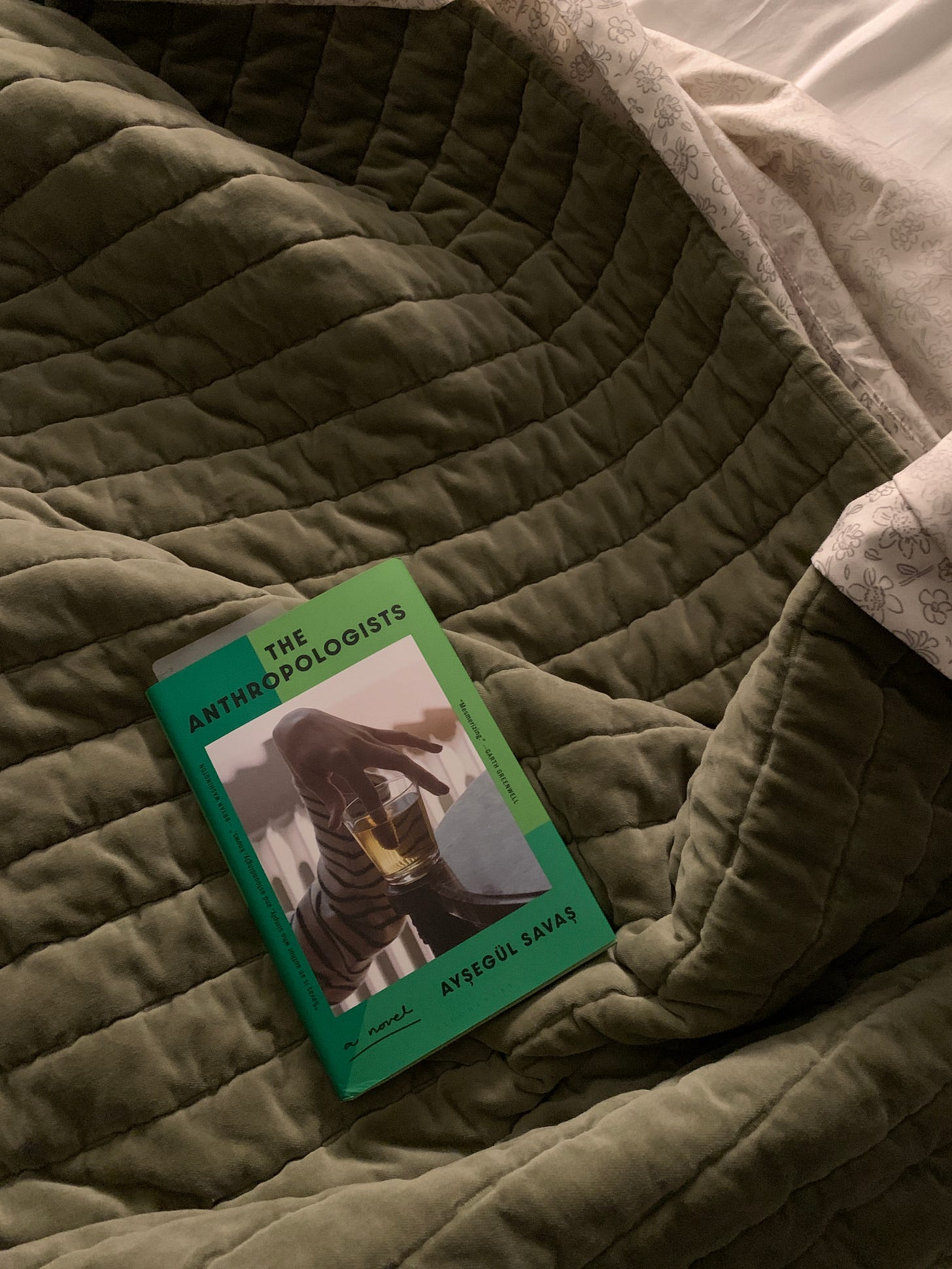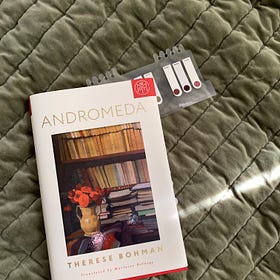Welcome to Notes, Quotes, and Reflections, aka a look inside my reading journal. This week I’m logging The Anthropolgists by Aysegul Savas.
Title: The Anthropologists
Author: Aysegul Savas
Published: Bloomsbury Publishing, 2024
Read Date: February 14-22, 2025
I read this in February and don’t remember much about my reading experience other than the crumbs I left in my notes. This is exactly why I am trying to be more consistent with reading notes, because it’s so easy for a book to slip out of memory. I want to remember the circumstances of my life while reading a book as much as I want to remember the content.
This short, vignette-y novel is quiet, meandering, and focused on the way daily occurrences create a life. I find myself reading a lot of books that comment on this theme recently. I suppose I am subconsciously drawn to this idea, because I need the reminder that daily life is life. I have been more actively cultivating presence and gratitude and joy in the mundanities of my days, recognizing how meaningful they are. There is nothing else in life beyond the ability (and the privilege) to enjoy our days.
I think the simplicity of this novel can leave it sitting under the radar. But reflecting on my reading year thus far, this stands out as one of the better pieces of fiction I’ve read.
“All this time, we were waiting. For the news of some momentous change; that we were being summoned to serve in real life; that the time for playing games was over. We lived with the abstract shape of the news, informing us that it had arrived. We lived with the imaginary shock. Maybe, I thought, it would also be a relief: Here it was, finally. Here was life itself.”
Reading Notes
Assuming the city is Paris?
New Yorker story “future selves”
I like the idea of observing your own life as an anthropologist—not always, but as an exercise. to step back, pay attention, note your daily routines, your rituals, the things that bring you joy, the small things that all add up to create something bigger. a life.
I have an entire rack of metaphorical green jackets to look at every day
I’m desperate to go rot in the park—when will winter end?
Lena, girl…I know.
eat Caesar salad, lay in the park, bask in the sun
we are helpless creatures who just crave sunlight!
I’m dedicated to becoming a true regular at my park this year, I want to be on nodding terms with the power walkers
Did not even put 2 & 2 together—but Savas wrote the intro for my edition of Cold Nights of Childhood. It makes sense that I ended up reading these 2 novels so closely together and seeing similarities.
Further Reflection
What makes a home? What makes a life?
We are so often concerned with our future selves, our future lives, that we don’t see life happening right in front of us. We are always waiting around for it to finally start, as if the now doesn’t quite count as a part of the whole.
In The Anthropologists, Aysa and Manu are looking to buy an apartment. Aysa is a documentarian, interviewing people who frequent the local park. She spends a lot of time observing others—an outsider, not native to this place, she wonders how others build a life here, how they manage to slide into the days so seamlessly. Despite having lived here for years, she’s still waiting for the city to become home, waiting for the day her and Manu can set their lives in motion.
She compiles a list of elements that might contribute to “a good life”, like a specific green jacket she likes to look at, and dinners with her upstairs neighbor where they read poetry aloud to each other.
Through a series of vignettes, we see their day-to-day living, the neighborhood spots they frequent, their friendships that have become familial, and the small rituals that keep them close. And these are precisely the things that make a life. It turns out the living has already begun.
Quotes
“All these were the unspoken foundations of our society, whose rules we had perfected, so as not to think of them as rules but as the smooth tracks of life. From time to time, the professor would ask us to imagine an anthropologist observing the everyday routines with which we had set up our lives. They might be arbitrary or essential, but they were rules to a game nonetheless, one which gave an illusory sense of harmony and permanence.” (p. 28)
“What would the tiny anthropologist point to in our makeshift apartments, where we lived without a shared native tongue, without religion, without the web of family and its obligations to keep us in place? What would she identify as our rituals and ties of kinship, the symbols that constituted a sense of the sacred and the profane? Because it often seemed to me that our life was unreal, and I summoned the anthropologist to make it seem otherwise.” (p. 29)
“I mistrusted the woman’s process of abstraction, simply because I’d grown so weary of life in the abstract. For most of the people we were acquainted with, Manu and I were nothing more than our countries of origin, our accents, our work. And I yearned for a specific existence.” (p. 44)
“[T]hey were doing work on themselves, as if the psyche were a house for remodeling, its parts identifiable as rooms and walls and beams, its leaks and fissures possible to fix. And it seemed there was always a limit to how genuinely we would be able to know them, because constant calibration of their own well-being wouldn’t allow true intimacy.” (p. 71)
“The green velvet jacket was still hanging behind my chair. I hadn’t worn it yet, but I was encouraged by its reminder of how I wanted to be in the world. The definition changed every time I articulated it to myself but the feeling was palpable. Playful, assertive, and a bit old-fashioned. So there was the green jacket, for a start. And there was our breakfast ritual, before Manu went to work. There were the stones our ancestors had placed at burial sites. All these were elements with which I wanted to build a home.” (p. 88)
“But in the end, it’s the people that make a place. I could live anywhere with the right people.” (p. 157)
“All the months that I had been filming, I’d thought that there were so many ways of living, of inhabiting the park. I wanted to know as many configurations as possible, all the strange and unique ways. But lately, as I went over the scenes again, smoothing their edges, positioning them into a fluid conversation, I’d begun to understand that there was, also, only one way to live beneath the multitude of forms, one way forward through the fleeting hours of a day.” (p. 165-166)
Resources
previously…
Andromeda
Welcome to Notes, Quotes, and Reflections, aka a look inside my reading journal. This week I’m logging Andromeda by Therese Bohman.
Thanks for reading today’s issue of Empty Head. Subscribe to receive future issues of Open Tabs, more bookish musings, and misc. writings in your inbox/feed. And of course, please share if you feel so inclined!




Serendipitous! I’m editing a newsletter on The Anthropologists this very moment —loved reading your notes & collected quotes here!
Thought you might enjoy — we recently spoke with Savaş for Women of Letters: https://womenofletters.substack.com/p/aysegul-savas